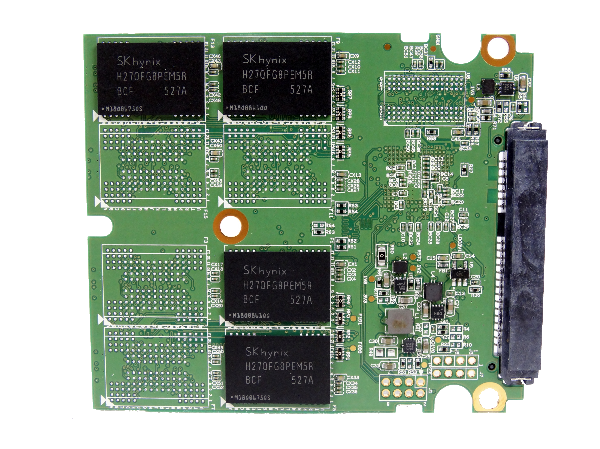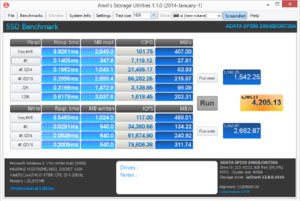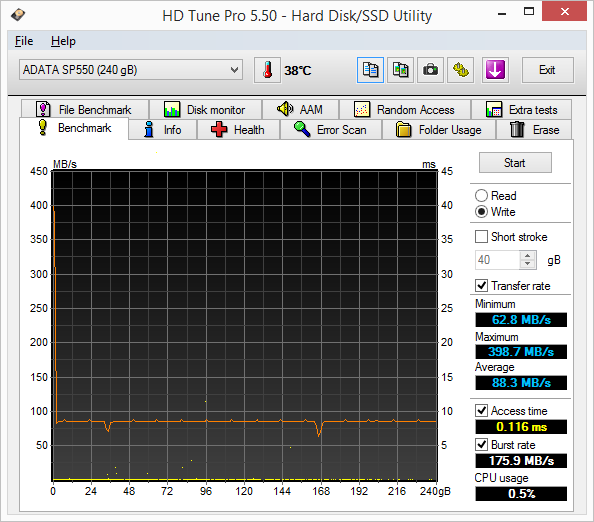Adata SP550 SSD Review
Adata's SP550 is the first SSD to hit our lab with Silicon Motion's new SM2256 controller paired with SK Hynix NAND. But does it compete with Samsung's prolific 850 EVO?
Why you can trust Tom's Hardware
A Closer Look
We have all three Adata SP550 capacities in-house. The initial release takes this line-up to 480GB, with a 960GB model expected in the future.


This packaging is several years old, dating back to Adata's first hummingbird logo design. It was introduced alongside the first SandForce-based SATA 3Gb/s drives.
The front of the box lists several product features as well as the three-year warranty. On the back is four-corner performance data for all three capacities.
Inside, we see the SSD, a 7mm-to-9.5mm adapter and a quick-start guide. The paper manual includes installation instructions and a link to download Acronis True Image HD.




The Adata SP550 uses a 7mm chassis, so it'll fit in newer Ultrabooks requiring a lower-profile enclosure. Overall, the SP550 is fairly vanilla-looking, though at the same time functional.




Opening each drive up, we find the new Silicon Motion SM2256 controller paired with Samsung DRAM and the first triple-level-cell SK Hynix flash we've ever seen. Our performance charts include the Longsys Foresee S500 with the same SM2256 controller; however, it's matched up to Toshiba's A19 TLC. It will be interesting to compare both platforms and determine if Adata chose the better flash vendor.
Data Type Comparison & SLC Cache


Silicon Motion's SM2256 doesn't employ compression, so there isn't a penalty for hitting the drive with incompressible data.
Get Tom's Hardware's best news and in-depth reviews, straight to your inbox.
TLC flash presents several issues that need to be compensated for. Here we see that native 64KB block sequential write performance is less than 100 MB/s. That's lower than what you'd get from many low-cost mechanical disks, and half of the sequential write performance expected from the quickest 7200 RPM models.
As mentioned, to combat low write performance, manufacturers often set aside a portion of the high-density TLC, turning it into emulated SLC flash. This yields a 3x reduction in capacity for those cells, but a 4x increase in performance. As you might imagine, there's a balance to be struck between too much space dedicated to SLC, eating up capacity, and avoiding the TLC write penalty. As you can see on the above graph, Adata's SP550 only gets a small does of SLC, so you'll probably experience low sequential write speeds during file transfers or software installs.
Current page: A Closer Look
Prev Page Specifications, Pricing, Warranty & Accessories Next Page Four-Corner Performance Testing
Chris Ramseyer was a senior contributing editor for Tom's Hardware. He tested and reviewed consumer storage.
-
Eggz A little boring, but I guess this would be good for a value build with an AMD chip for decent performance at a pretty low cost.Reply -
jjb8675309 The 240GB model is a good value but the 250GB EVO is going for $80 right now, I'd probably get that if faced with the choice.Reply -
Rookie_MIB Currently listing on Newegg for $42/$64/$119 for the 120/240/480GB.Reply
$119 for a good name-brand 480GB drive that performs decently enough is good to see, as a 1TB drive should come in right around the $200 mark.
The only thing is, and it's probably why the 960GB hasn't been released is that based on the performance of the 480GB drive they probably have to put in and validate a different controller. The 4 channel controller would just run out of bandwidth trying to handle all the data and would lose out on the parallelism which makes SSDs as fast as they are. So - they'd need an 8 channel controller for sure which might jump the cost a bit. -
zodiacfml If that's the conclusion then Adata has better SSDs compared to Crucial's latest drives. Samsung pretty owns the market due to being also a NAND manufacturer.Reply





